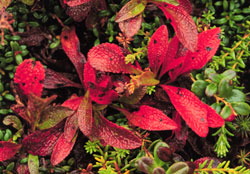|
|
 |
 |
 |
Miniature plants of the Arctic tundra.
photo © C. A. Linder |
Images and Facts - Facts
Gallery | Dispatch Images | Facts | References
Plant Life
by C. A. Linder
Plants form the base of the food chain both for terrestrial (land)
and marine (ocean) organisms.
The Arctic tundra is a unique ecosystem due to the length of its growing
season and the existence of the permafrost table. The tundra is dominated
by ankle-high miniature plants such as the Arctic willow and dwarf
birch. Why is the tundra treeless? The primary reason is that the
growing season is so short. Although the Arctic is bathed in light
during the summer months, the temperature must rise above a certain
level in order for the plant tissues to be able to photosynthesize
(i.e. make food). If the growing season is very short, plants must
expend all of their available energy into producing leaves (for producing
more food) and roots (for anchoring the plant and storing food for
the winter). If the plant has only a little energy left over for growth,
the plant by necessity remains very small. The northern boundary of
tree growth is referred to as the "treeline." This is the
zone between the dense evergreen taiga forest and the treeless tundra.
It is closely linked to the average temperature.
Permafrost (permanently frozen soil) is the other important factor influencing plant growth in the Arctic. The permafrost table is a layer of soil which remains frozen year after year. It is thin (only a few inches) in the southern subarctic but becomes very thick (up to 2000 feet) in the High Arctic. On top of the permafrost layer is the active layer, a soil layer which thaws in the summer. Since the sun's energy is greater in the south, the active layer is much thicker (up to 12 feet) in the subarctic compared to the High Arctic (a mere few inches). Plant roots are limited by the depth of the permafrost -- they can only survive in the active layer. With 12 feet of growing room in the subarctic, trees can develop deep root systems which will support a tall tree. Conversely, with only a few inches of active soil a plant cannot develop sufficient roots to support a heavy trunk. This is another reason that tundra plants grow so low to the ground.
At the base of the marine food chain are tiny plants known as phytoplankton.
Like terrestrial plants, they require nutrients and light to grow.
During an Arctic summer, the continuous daylight leads to an explosion
of phytoplankton growth. Since they are at the base of the food chain,
all Arctic animals are dependent upon these tiny organisms for survival.
One of the ways that scientists measure phytoplankton is to measure
ocean color. The satellite image (left) shows blooming phytoplankton
in the Chukchi Sea. Click here
for more information on phytoplankton.
Back to Facts Index
|
|




